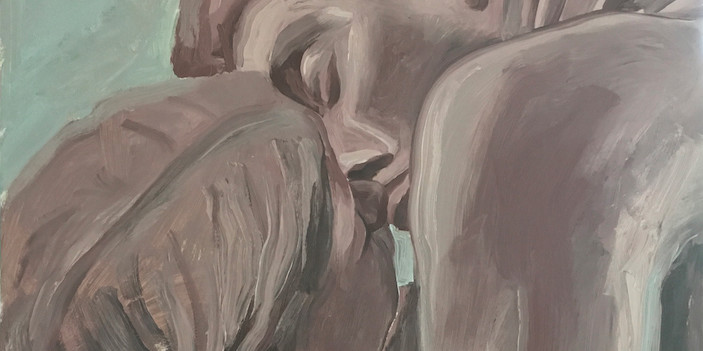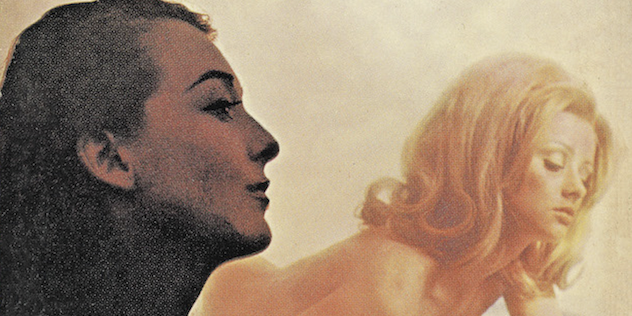TESSA HADLEY’S NEW NOVEL, Free Love, begins in 1967 London. The book is split between Otterley, a fictional suburb of manicured houses and back gardens, and Ladbroke Grove, the site of hippie excess, progressive dropping out, and émigré professional striving. Hadley focuses on Phyllis Fischer, a forty-year-old housewife, and her fifteen-year-old daughter Colette. The attention to these two characters, as they break slowly and then all at once from the circuits of the lives expected for them, makes up the bulk of the plot. Phyllis is elegant, the well-groomed and beautifully dressed mistress of a tidy and perfectly kept Arts
- print • Mar/Apr/May 2022
- print • Mar/Apr/May 2022
THE SCHOOLGIRLS HAVE BEGUN TO BEHAVE STRANGELY. At night, they gather to perform incantations that involve crystals and candle wax, delicately dripped. One of them hides sambuca in a mouthwash bottle and slips out for parties after babysitting jobs. Another attempts suicide by smashing a thermometer to drink the mercury within, but only succeeds in cutting herself. The last stops eating altogether, unless she can cadge food off of someone else’s plate.
- print • Mar/Apr/May 2022
IT IS TECHNICALLY POSSIBLE to write about Sheila Heti’s new novel, Pure Colour, by following the rising action. Such a review might track Heti’s main characters—father and daughter—through his death, her long mourning, their reunion in a leaf (it’s a sort of limbo), and her learning to live without him. The idea would be to shepherd readers through the novel by focusing on its most legible story line, in the hopes of making it all make sense. At the end, three or four sentences would remain to pronounce one or two judgments on how Heti perverts or expands the nature
- excerpt • December 9, 2021
At some point in moving from The Savage Detectives to 2666, Bolaño sketched a map (or diagram, or dream image) of Santa Teresa, the city on whose outskirts Cesárea Tinajero dies in the earlier book and that would become the center of his final novel. The picture (which you can find in the exhibition catalogue Archivo Bolaño 1977-2003) looks like a classic grid in a process of decomposition: names of landmarks or neighborhoods float in a disjointed space connected by gestural lines indicating streets or thoroughfares. But even in this exploded condition, we recognize how Bolaño’s imagination tends to geographical
- print • Dec/Jan/Feb 2022
ANDRÉE’S GRAVE IS ALL WRONG, Sylvie thinks. It’s covered in white flowers. This is what killed her; she was “suffocated” by whiteness. Sylvie places three red roses on top of the grave. This scene takes place at the end of Simone de Beauvoir’s roman à clef Inseparable: Sylvie is Simone and Andrée her friend Élisabeth Lacoin, known as Zaza. In real life, there must have been a casket for Zaza, who died at twenty-one, and maybe also roses, but in Beauvoir’s Memoirs of a Dutiful Daughter (1958), where Simone and Zaza’s story is recounted, we hear nothing of the casket
- print • Dec/Jan/Feb 2022
WHEN SHE WAS SIXTEEN, THE FRENCH NOVELIST Anne Serre set out to induce her high school philosophy teacher to fall in love with her. Her strategy was unconventional: “I thought that writing a book, which I would then ask him to read, was the only possible way of seducing Monsieur Rebours,” she recounted in the Times Literary Supplement last year. Though Monsieur Rebours did not succumb, Serre, now sixty-one, remains convinced that books are instruments of seduction. “Fiction, realist or not, doesn’t try to convince but to seduce,” she explained in a recent interview. “A writer’s only responsibility is to
- print • Dec/Jan/Feb 2022
IN AN AFTERWORD WRITTEN to accompany the 1990 reissue of her second novel, 1952’s sapphic paragon The Price of Salt, Patricia Highsmith insisted, “I like to avoid labels,” taking umbrage even at being called a suspense writer. The declaration functioned somewhat as a misdirection, deployed to explain why she published the book pseudonymously (as Claire Morgan), though not why she refused until almost forty years later to publicly acknowledge—and thus out herself—that she was the author of this swoony tale of same-sex romance: “If I were to write a novel about a lesbian relationship, would I then be labelled a
- print • Dec/Jan/Feb 2022
SHE CALLED HERSELF a minor writer. “I’m no Tolstoy,” said this woman whose parents named her after a character from War and Peace. One wishes Natalia Ginzburg hadn’t apologized for her gifts. Wishes that she had luxuriated in her standing as one of Italy’s finest postwar writers. The fact that her various novels, novellas, and essays are flying back into print—some freshly translated—thirty years after her passing is not unrelated to the extravagant success of the other Italian, the one whose books have become the stuff of prestige television. Ginzburg, alas, has no HBO series attached to her name, but
- print • Dec/Jan/Feb 2022
ALEXANDER CHEE: You have never shied away from writing about the events of the world, but your new novel, A Time Outside This Time (Knopf, $27), takes that on in a different way: a novelist at an artist’s colony considers whether the violence in the world outside the retreat is an interruption or a muse.
- print • Dec/Jan/Feb 2022
THEY APPEAR TO HER in the middle of the woods. Marie, the heroine of Lauren Groff’s novel Matrix (Riverhead, $28), is hard at work with her nuns building a labyrinth that will make their twelfth-century English convent impenetrable to intruders, when she has a vision. “I fell to my knees, for standing in the place where the road was to be made in the forest were two women whose holiness shone so brightly their radiance made me hide my face from them.” It is the Virgin Mary, together with Eve, the Biblical first woman. They bear matching wounds. On Mary’s
- print • Dec/Jan/Feb 2022
GENERICALLY SPEAKING, THERE’S JUST ONE QUESTION driving the Künstlerroman, and it’s “How does this person become an artist?” That narrative-driving “how” relies, however, on the rather more metaphysical matter of “who.” For any artist-narrator worth their salt, this inquiry is depthless—its richness residing in unanswerability, but also in the complicating and exciting fact of art and selfhood’s imbrication. Via Stephen Dedalus and his successors we duly understood that the growth of the person and the growth of the writer are coterminous, that self-knowledge and artistic integrity might, essentially, be the same thing. What happens, though, when the portrait is not
- excerpt • October 12, 2021
So, as he always said himself, W. G. Sebald is not a novelist. Nor a travel writer, since his journeys and landscapes are more inward than outward. He is a historian, biographer and autobiographer. But beneath these, he is at heart a visionary and a mystic. That is why there is no one like him in modern literature.
- print • Sept/Oct/Nov 2021
WHEN, LATE IN JONATHAN FRANZEN’S NEW NOVEL CROSSROADS, a woman, reuniting with an ex-flame after thirty-one years, notes “recent Mailer, recent Updike” on his shelves, the shock of the old is both soft and profound. It’s 1972; the dinosaurs still stamp and bellow. They can’t imagine how much they will lose.
- print • Sept/Oct/Nov 2021
MIRIAM TOEWS IS THE RARE NOVELIST for whom “write what you know” does not amount to conservative advice. Toews was born and raised in an insular Canadian Mennonite community called Steinbach. Her eventual rebellion, which included a stint touring North America in a dilapidated VW van with a fire-eating street performer, was nearly as thorough as the rigidity of her earlier life. Toews has shaved her head and hitched rides with punk bands. She has been a single mother on welfare. She has witnessed the debilitating depression that culminated in the deaths of both her father and older sister. Versions
- print • Sept/Oct/Nov 2021
I DROVE ACROSS the Everglades in May. I had originally planned to take Alligator Alley, but someone tipped me off that, in the twenty years since I left South Florida, the historically wild and lonesome stretch of road had been fully incorporated into I-75, turned into a standard highway corridor with tall concrete walls on both sides, designed to keep the traffic noise in and the alligators out. So on the drive west from Boynton Beach, I took the northern route, skirting along the bottom of Lake Okeechobee (which you can’t see from the road) through new subdivisions and past
- print • Sept/Oct/Nov 2021
THERE IS ONLY ONE literal afterparty in Afterparties, the debut story collection by Anthony Veasna So, who died last year at the age of twenty-eight. It appears about halfway into the book, as the organizing event of “We Would’ve Been Princes!”—though the event itself, as readers quickly learn, isn’t all that organized. The story opens right as a wedding party starts winding down and is broken into seven acts, each escalating in sloppy and somewhat digressive debauchery. As the afterparty grows more unruly, gathering a range of distantly related Cambodian cousins under one roof, so too does So’s narrative—spilling into
- print • Sept/Oct/Nov 2021
“WE FEEL AN AFFINITY with a certain thinker because we agree with him,” writes Lydia Davis in “Affinity,” one of the shorter stories in her collection Almost No Memory (1997). Yet according to Davis, it wasn’t a sense of kinship that led her to the zeer korte verhalen (zkv’s), or “very short stories,” of the beloved and prolific Dutch author A. L. Snijders (1937–2021). Rather, it was a sense of fairness: if her books were being translated into Dutch, then she should translate a work from Dutch into English. It would be no small challenge, since she would have to
- print • Sept/Oct/Nov 2021
PERCIVAL EVERETT’S NEW NOVEL begins in Money, Mississippi, the town Emmett Till was visiting from Chicago when he was lynched in 1955. The fourteen-year-old Till was tortured, mutilated, and shot in the head. His killers, Roy Bryant and J. W. Milam, tied his corpse to a cotton gin with barbed wire, and dropped it in the Tallahatchie River. They were tried and acquitted, and, though they admitted their crime to a journalist for Look magazine the next year, rules against double jeopardy ensured they were never brought to justice. The Trees opens at a family gathering of the descendants of
- print • Sept/Oct/Nov 2021
THE STORY GOES THAT ONLY FORTY PEOPLE attended the Sex Pistols’ first concert, but each of them went on to form a band. A similar thing might be said of Tao Lin; his first few books had small readerships, but those who read them went on to write their own plotless, autobiographical novels in which emotionally stunted twentysomethings communicate on their laptop computers via Gmail chat. Lin’s early style was deceptively simple, a robotic deadpan marked by an absence of figurative language and a lack of abbreviations (always “laptop computers,” always “Gmail chat”) that captured a particular strain of millennial
- print • Sept/Oct/Nov 2021
AS THE CIVIL RIGHTS MOVEMENT took center stage in newspapers and magazines across the United States, the people of Harlem were, among many things, dealing with a rat problem. The vermin were biting children and contaminating pantries, but they were also a striking symptom of a larger issue: Harlem was facing a housing crisis. Though public housing had been erected, it was both scarce and disgusting. The exuberance that characterized the Harlem Renaissance of the 1920s seemed to be in decline as economic insecurity, inadequate sanitation, dreadful landlords, and neglected public space tarnished the neighborhood’s grandeur. As James Baldwin would



















